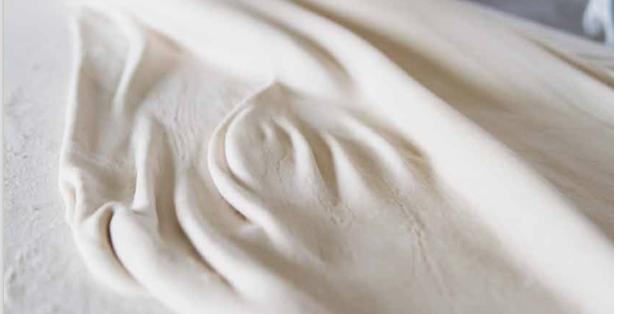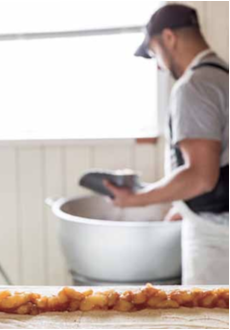Rare things happen in the most unremarkable of places. Outside a narrow Downriver building, where gaps in vertical blinds reveal little more than a few windowsill houseplants, only a small sign— Hungarian Strudel Shop—hints at the Old World process within. Inside, just beyond a display case of fresh-baked confections and a framed photograph of Hungary’s ornate parliament building, is a barebones backroom where the morning activity is nothing short of fascinating.
Here, Helen Dawson works magic, transforming our, water, shortening and a pinch of salt into a voluptuous expanse that looks and feels more like fabric than dough.
While morning commuters edge along in rush-hour traffic on nearby Southfield Road in Allen Park, Dawson goes to work.
She positions a smooth, 10-pound disk of dough into her electric sheeter, a mechanical rolling pin of sorts, that flattens the thick round into a thin rectangle. Three trips through the sheeter produce the pastry sheet she needs to begin working magic on a surface resembling a giant Ping-Pong table covered with a tablecloth.
In almost reverent silence, with only a few quiet directives spoken to her work partners, Dawson quickly and expertly stretches the raw material as far as it will go, making a 20- by 25-foot sheet. She knuckles and tugs the elastic, high-gluten dough and gives it an elevating shake, as if snapping a king-size bed sheet so that it billows up, then settles softly back into place. Dawson and her two or three table partners—family members, usually—are in constant motion: Circling. Stretching. Trimming.
Larousse Gastronomique, the culinary encyclopedia, says strudel translates to “whirlwind.” That applies to Dawson, as she deftly stretches the dough in a sort of workroom waltz. Larousse says strudel was inspired by the Turkish baklava.
Phyllo dries quickly and is highly sensitive to ambient elements. Because Michigan air is humid, Dawson is forever fine-tuning
the shop’s fans and dehumidifier for optimal levels. She has been finessing phyllo for four decades, producing at least 1,200 strudels a week.

As Dawson describes the process, her hands reflexively move in a caressing motion. “My favorite part is the stretching,” she says. After that comes trimming, dusting with a mixture of breadcrumbs and sugar, a light sprinkling with melted shortening to help it brown, then filling and rolling, slicing into lengths and boxing.
Standard fillings include apple, apricot, blueberry, cheese, cheese with fruit, cherry, walnut and, in autumn, pumpkin. For Dawson, a piece of each flaky finished dessert is a slice of her life.

Dawson’s family, the Arnoczkis, came to Detroit in 1956 as refugees fleeing the Hungarian revolution. They settled in Delray, which was then a thriving Southwest Detroit ethnic enclave near Holy Cross Church, whose parish priest, along with their great aunt, sponsored their U.S. entry.
Eventually, Dawson’s mother, Emma, bought a strudel-making business from a Hungarian-German couple, and ran it with Dawson’s brother, John. Dawson worked for them for years until her mother retired and she bought her mother’s share of the operation.
Dawson’s mother and brother are gone, now, making her business even more of an endangered species. “It’s a lost art, even in Hungary,” she says. “People aren’t doing it today by hand. It’s very physical, almost like making a custom sweater.” The daily exertion has given her buff baker’s muscles—a look that, these days, is more likely to come courtesy of the gym.
As the Houston Chronicle noted several years ago: In this era
of home-brewed beer and cottage-industry butter, ricotta and charcuterie, “phyllo has been left, by and large, to a dwindling number of grandmothers.” Those “grandmothers” know that old-country lore suggests two tips for making good phyllo: You should be able to read a newspaper through a properly thin layer of prepared dough, and there should be an added measure of spiritual respect.
“Little old ladies always blessed the dough,” Dawson says. “If it didn’t turn out well, they’d say, ‘Did you make the cross?’ ” Dawson still honors that tradition. There, amid the 50-pound bags of Bouncer-brand flour and tubs of Sweetex shortening, she makes a sign of the cross over the mixer.
For Dawson, such cultural rituals are a connection with her revolution-era girlhood, a time when she heard adults talk of tanks “rolling people as flat as crêpes.” “[When the tanks came] I waved to them,” she says. “I thought if I was friendly, they wouldn’t flatten me.”
Today, her welcoming hospitality comes in the form of ray-tesh, as the word strudel sounds phonetically in her native language. “I like it warm with ice cream,” she says. That’s how her confection
is often served in restaurants that purchase it wholesale—raw and frozen—for baking on-site. Caterers also order the strudel for events, including weddings. Individual customers may buy the pastry ready-to-eat or frozen with instructions to bake it at home. It’s best enjoyed on the same day it’s baked.
“I never sell day-old strudel,” Dawson says. The only “old” aspect is the tradition, which she hopes to pass on one day to a buyer willing to learn and preserve the craft. “It’s a lot of hard work, so you have to like it,” Dawson says. “It’s a labor of love.”
Hungarian Strudel Shop, 6816 Park Ave., Allen Park; 313-383-3440
Rebecca Powers is a metro Detroit writer and editor. This piece was originally printed in Edible WOW’s Spring 2015 issue. Contact [email protected] for more information.
